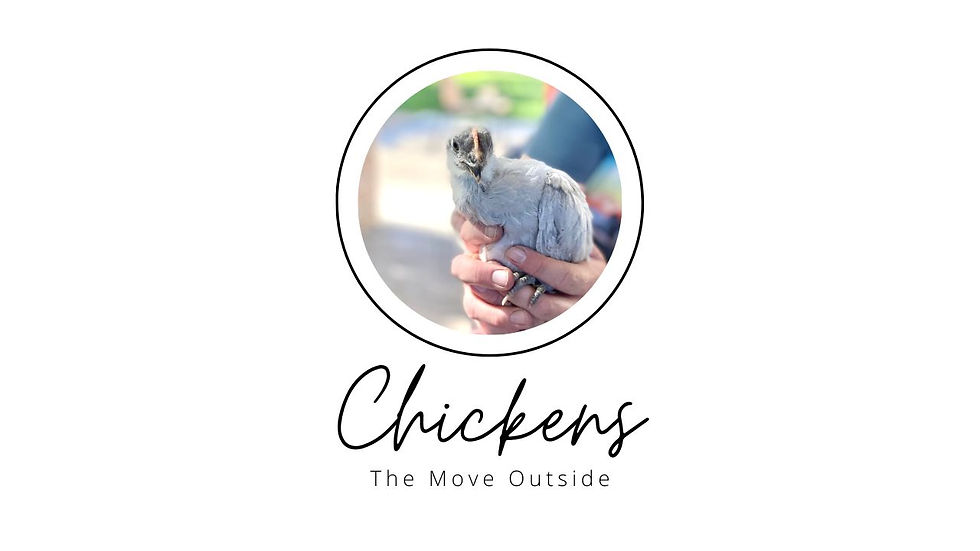They grow up so fast.

And just like that, your chicks have gotten taller, are no longer fluff balls, and more active. This is an indicator that it is time for them to move outside. The time for each breed varies. It can be as soon as 6 weeks, or later at 10 weeks. There are a couple of factors that determine this.
Weather. Is there still a chance for Spring frost? You do not want them in the cold. If it is staying in the 70s during the day and 50s at night, they will be fine. I think 40F at night might be a little chilly for them, but you could try a heater (not a heat lamp, a chicken coop heater).
Fluff. Is the fluff gone? Once a chick has lost it's fluff and they are mainly covered by "adult" feathers, it is a sign they are ready. Plus, you will notice them trying to fly more.

So, it's time to move the chicks outside, so what do you do?
Acclimate - You want to get them used to being outside, so you will want to use a dog kennel or something to secure them for outside visits. These visits start at 10 minutes once a day then twice. Then it progresses to 20 minute increments. I start doing this just before they loose all their fluff. It's a week, or two of acclimation.
Move Out - Once it is go time, you just put them in their coop with fresh water and feed. I might start transitioning feed by mixing the chick crumbles with layer crumbles at this time as well.
Monitor - Check on them through out the day (if possible) their first couple of days. They will be fine though as long as you have a secure space for them.
That's pretty much it! But what if you have adult hens already in the coop and you have chicks to add. Well, now that's a bit more work...
Still Acclimate - But you will also want to start setting the kennel near the coop so the chicks and the hens can see each other. Don't put too close as the hens will peck at the chick.
Free Range the Hens - If you can, free range the hens and set the kennel out with the chicks. I would do this for a week or two. Free ranging with the hens is one of the better ways to incorporate chicks/pullets with hens. The hens will have free ranging finds to focus on and may not peck at the chicks as much.
Small Kennel or Pen for Move Out - Once moving out, you will want to put the kennel in the coop or right next to it. Do this as long as you need till the chicks are big enough to not seem and not too small next to the hens as they will absolutely pick on them.
The Move In with the Hens - Two ways
At night place the younger pullets in the coop with the hens. This will make it so the hens will be calmer and will less likely pick on the young ones.
Free range the hens and let the pullets out. Monitor them and pull back the pullets/chicks, if needed.
Be Ready for Pecking - The pecking order is real and this will be on display at this time. If the hens get too mean, I use a water gun and shoot at them. Or I pull in the young ones and try again the next day.
Chick Haven - Once the chicks are out with the hens, make sure to have a place for the chicks/pullets to retreat with water and food if they need. It might be making a small enough entrance that the hens can get through.
I'm going to be honest, I think dealing with integration of chicks/pullets and hens was one of the most stressful times of chicken ownership. It takes time and you have to just feel it out. It's not going to happen in one day, it might take weeks. This year I had 2 sets of chicks at different stages so I went through this integration phase back to back. It was exhausting as it took probably a good 2 months. Also, I wasn't able to free range the hens as that is a better way to integrate, I've read, so I had to do it in my large run, but sometimes it didn't seem large enough. At points, I thought they were never going to get along. One day they all started walking around peacefully though. There are still little kerfuffles, but nothing like the integration days.
I also think having a pullet turn out to be a cockrel (young rooster) also helped as all of a sudden there was a male in the coop and the hens were like, "What the heck is this?!." Roosters are supposed to help with the pecking order and I think my Lavender Orpington cockrel, Clark, may do that...he still gets chased by the Buff Orpington, Judy.
The move out and integration days may be the most challenging and unnerving, but once through it, life settles into a routine of feeding and cleaning.
Comments